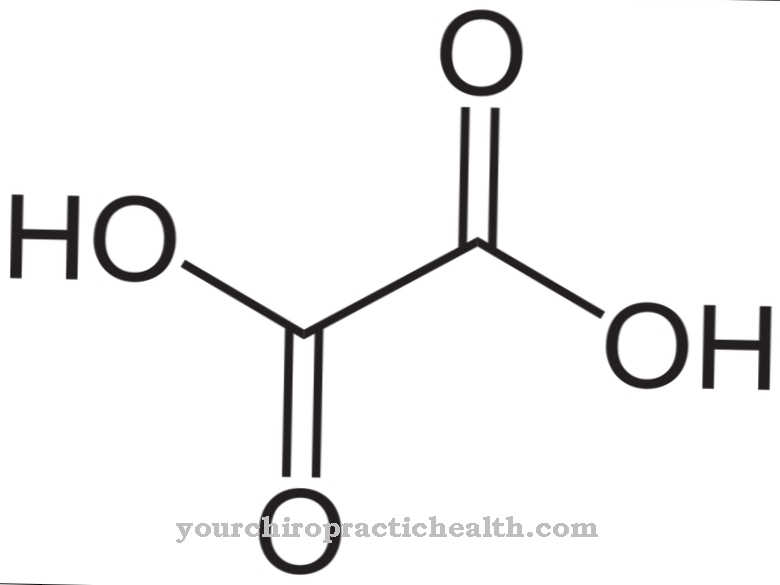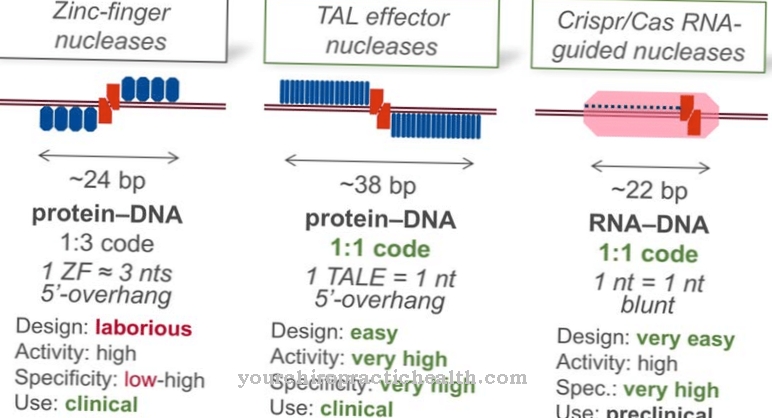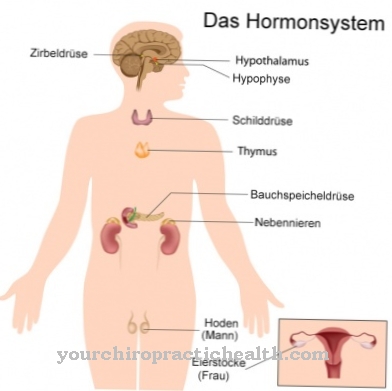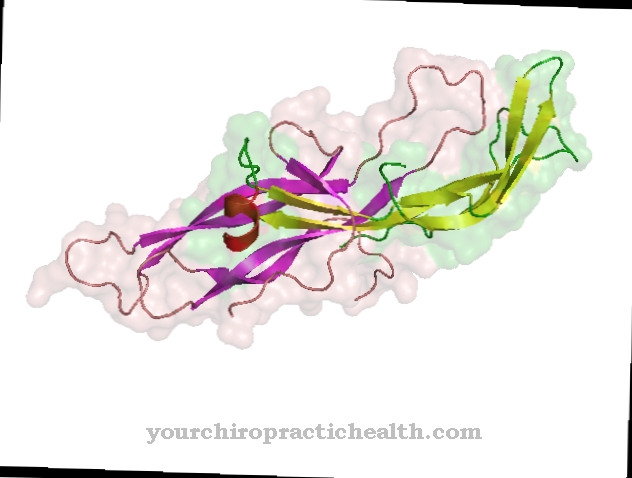From a chemical point of view is ammonium (NH4) the conjugate acid that belongs to the base ammonia (NH3). Ammonium is the most common breakdown product from the amino acid metabolism.
What is ammonium?
Ammonium is a cation. In its chemical reactions it is similar to alkali metal ions and, just like these ions, can also form salts. Examples of such salts are ammonium nitrate or salmiac.
In nature, however, ammonium is mainly produced when proteins are broken down. The bacterial decomposition of dead biomass also produces ammonium as the end product. Similar to ammonia, ammonium can also have a neurotoxic effect in the human body.
Function, effect & tasks
In the medical context, ammonia is often used in the body. Basically, this is not correct, because ammonia is almost exclusively in the form of ammonium ions in the body.
Ammonia or ammonium plays a role in many metabolic processes. However, ammonium is of particular importance in the formation and breakdown of amino acids. Glutamate is produced from ammonium and α-ketoglutarate in a chemical process. This process is also known as reductive amination. Glutamate is a so-called α-amino acid. It is also known under the name glutamic acid. Additional non-essential amino acids can be produced from glutamic acid by means of transamination. The amino acids formed in this way take on numerous tasks in the body.
For example, they are involved in the regulation of various metabolic processes or serve as a precursor to hormones. But glutamate is not only a precursor to other amino acids, it is also one of the most important excitatory neurotransmitters in the central nervous system (CNS). Neurotransmitters are biochemical messenger substances that transmit the stimulus from one nerve cell to another nerve cell or from one nerve cell to a body cell. Glutamic acid also serves as a precursor to γ-aminobutyric acid (GABA). This in turn is one of the most important inhibitory neurotransmitters in the central nervous system.
Education, occurrence, properties & optimal values
The largest amounts of ammonium are produced when amino acids are broken down. Most amino acids first break down to glutamate via the process of transamination. This in turn is split into the starting substances ammonium and α-ketoglutarate. The main place where ammonium is formed is the intestine. In the large intestine in particular, ammonium is released from undigested protein as a result of bacterial action. This then enters the bloodstream via the intestinal mucosa.
But ammonium is also produced in the muscles and kidneys. Since ammonium, like ammonia, has a toxic effect in larger quantities and cannot be completely converted back into new amino acids, the body must have a breakdown facility for ammonium. The ammonium in the blood quickly reaches the liver via the portal circulation. This converts the toxic ammonium into the harmless urea. Urea is a white, crystalline solid that is excreted in the urine. The normal values for ammonium in the blood serum are 27 to 90 µg / dl (micrograms per deciliter) or in conventional units 16 to 53 µmol / l (micromoles per liter).
Diseases & Disorders
An increase in ammonium levels in the blood occurs primarily when the liver is not functioning properly. Then the toxic ammonium can no longer be converted into the non-toxic urea. The most common cause of such liver dysfunction is alcoholic cirrhosis.
In cirrhosis, liver tissue perishes over a period of several years and / or is converted into connective tissue (fibrosis). This disrupts the blood flow to the liver. The blood accumulates in front of the liver, particularly in the area of the portal vein. This is also known as portal hypertension. Part of the blood from the unpaired abdominal organs then no longer flows through the liver initially for detoxification, but goes directly into the body's circulation. Even the blood that is actually still being passed through the liver can no longer be adequately detoxified due to the cell changes within the liver.
Those affected notice the first symptoms of cirrhosis (e.g. jaundice) quite late. If the brain is damaged by the increased ammonium levels, it is called hepatic encephalopathy. Initially, there is usually only a mild psychological syndrome. Often the changes are only noticed by friends or relatives at first. Typical symptoms at this stage are sedentary lifestyle, tremors or muscle twitching.
Later in the course of the disease, there may be an obsessive need for sleep, muscle breakdown, trembling of the hands and unsteady gait. Gradually there is increasing confusion. The most severe form of hepatic encephalopathy is hepatic coma. This is also known as a hepatic coma or coma hepaticum. At this stage the patients are unconscious and can no longer be awakened even with pain stimuli.
Ammonium in the urine is always a sign of calculus. Concrements are crystalline deposits of the urinary tract. They are also known as uroliths or uroliths. There are many different types of urinary stones. Ammonium is part of the so-called struvites. It is magnesium ammonium phosphate. Urinary stones can have different causes. Inflammation of the kidneys or ureters can lead to the formation of urinary stones.
Metabolic disorders such as gout, cystinuria or diabetes can also cause urinary stones. The stones often go unnoticed for a long time. Symptoms only arise when a stone becomes stuck in the renal pelvis or ureter. Extreme painful colic then occurs. Small stones usually come off by themselves, large stones have to be surgically removed or shattered by shock waves.













.jpg)

.jpg)
.jpg)











.jpg)